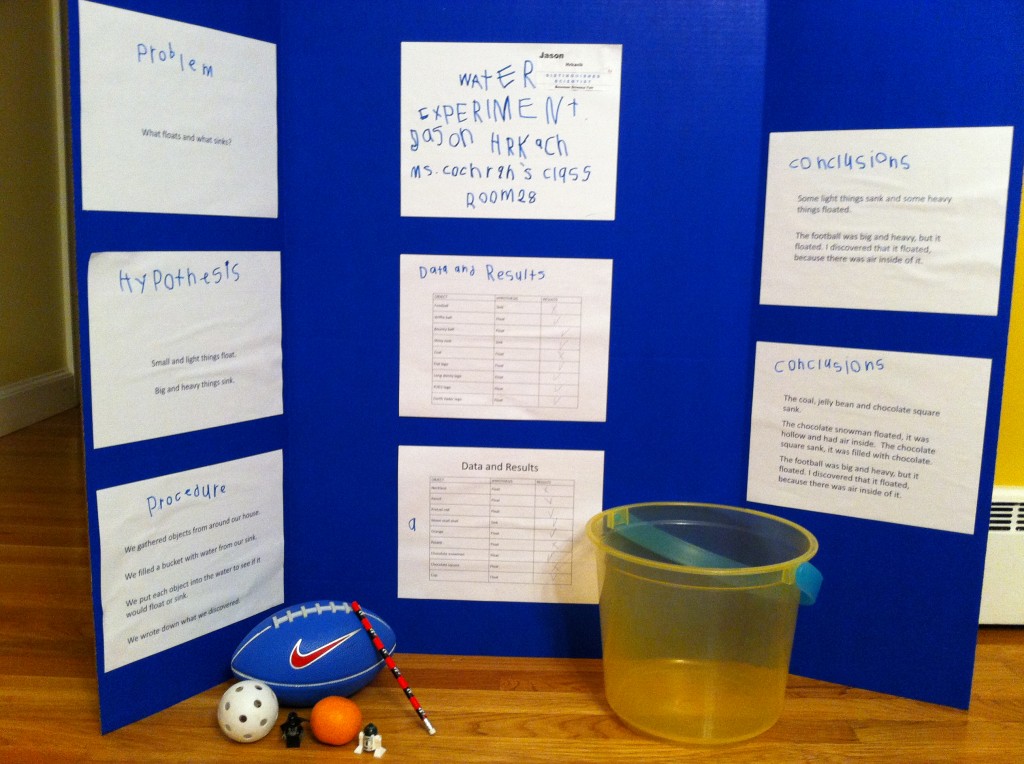Bowman Science Fair: What to Do
A sample science project exhibit.
1. Register Online
All students are welcome and encouraged to participate. Registration deadline has been extended to Friday, March 10.
Groups
You may work individually or in small groups. Group sizes are limited to three students. If you are working in a group, the group just needs to register once. Your group should choose one member to register for everyone.
2. Choose an Area of Interest and a Problem
You may already have an idea or a topic of interest that you’d like to investigate further. Or perhaps you need some help getting started. Either way, check out the Science Fair Resources page for links to museums, websites, and books to spark your imagination. There are so many potential topics that oftentimes the hardest part is narrowing down your selection to a very specific question. The “problem” is the scientific question to be solved. It is best expressed as an open-ended question, which is a question that is answered with a statement, not just a yes or no. For example, “How does light affect the reproduction of bread mold on white bread?” Be careful to limit your problem. The more specific your question is, the easier it will be to conduct your experiment.
Experiment vs. Demonstration
Traditionally, a science fair is for experiments, but you can do a demonstration if you would like. An experiment asks a question and tests outcomes by varying a single element in the experiment. For example, “What is the effect of salt on the boiling point of water?” You would then conduct your experiment by varying the amount of salt in the water and recording your results. Another example is “What size wheel rolls fastest down an incline?” Your experiment would consist of testing an object with different size wheels.
A demonstration shows a particular single effect, such as “The production of carbon dioxide by mixing baking soda and vinegar.” For the Bowman Science Fair, you can do either an experiment or a demonstration of something you think is interesting. However, we encourage you to ask a question and do an experiment.
3. Formulate a Hypothesis
After posing a simple question and doing some research, scientists usually formulate a hypothesis. A hypothesis is a “best guess” or a prediction of what the outcome of the experiment will be. This “best guess,” along with your background research will help you decide how to design your experiment. Your hypothesis is not always “the right answer” so try not to get hung up on choosing one. It is just an informed “guess.”
4. Conduct Your Experiment or Demonstration
Do your experiment or demonstration at home. Remember to stick to your method and record your results. The results of your experiment may be totally unexpected. This is okay. After your experiment is done, you will compare your results to your original hypothesis.
5. Reflect and Draw Conclusions
The conclusion is a summary of the results of your experimentation and a statement of how the results relate to the hypothesis. Your conclusion may or may not support your hypothesis. In your conclusion, you may also indicate what you might have done differently or what you might do if you were continuing your research.
6. Create Your Exhibit
After you have done your experiment at home, you should create your exhibit for the fair. Your exhibit should show visitors what you did and what the results of the experiment mean. In addition to having a display of your experiment, you should have some written material describing your work. A tri-fold, stand-up cardboard display can be used to make your display. The size of the display area should not be larger than 36” high by 48” wide. It should be folded vertically so that it stands up. You can purchase a display board from office supply stores or make your own. Visit the FAQs page for suggestions on where to purchase a display board. You can bring in materials you collected or used in your experiment or your demonstration materials to enhance your display. Bring items that will help you explain what you did and add interest to your exhibit. You can put these on the table in front of your presentation board, and refer to them while talking about your experiment. Remember, no messy or hazardous displays or demonstrations, and there will be no access to electricity. Your whole display must fit within a 30” x 30” space.
We suggest that you organize your display board in the following manner:

Please leave a 4” x 4” square of open space in the top right hand corner of your display board. You will receive a sticker at check-in on the night of the fair to identify your project so that our Visiting Scientists can find you.
Your display board should contain the following elements:
a. Problem
b. Hypothesis
c. Procedure
d. Data
e. Conclusion
f. Future or Next Steps
7. Set up your Exhibit
On the day of the fair, the exhibit room(s) will be available for setup starting at 6:40 PM. Please arrive promptly so that you’ll have time to find your location and setup your exhibit. Exhibits will be displayed from 6:55 PM – 8:15 PM so that students, friends, and family can see the exhibits. Each student needs to stay by their exhibit during this time to explain the exhibit to the visitors. Visitors will have lots of questions and will be very curious about your exhibit, so be prepared to explain what you did, how you did it, and to answer questions people have. A visiting scientist will stop by to hear about your experiment and award you a ribbon. Exhibits will not be judged.
A Note about Adult Participation
Parents should help as much as needed, but remember that it is the student’s project. Students will get more out of the science fair if they do it primarily themselves. They will need supervision if their project requires cooking, heating, flames, sharp object, chemicals, or other potentially dangerous objects. Please keep in mind that no hazardous or messy displays will be allowed at the fair itself. You may wish to review the science fair rules.
Contact Us
If you would like more information, or are interested in volunteering to help make the Bowman Science Fair a success, please contact us at sciencefair@bowmanpto.org.

